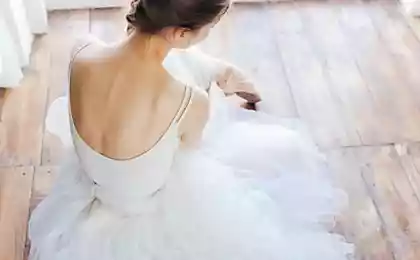1101
Speculation about our future (1 photo + text)
Interesting guesses about what awaits humanity in the future.

Interesting guesses about what awaits humanity in the future.
Less than 10 000 years ahead
~ 320 years - the Chernobyl Exclusion Zone would be suitable for life.
~ 600 years - a time when, in accordance with modern ideas about the boundaries of the constellations,
precession of the Earth's axis will shift the vernal equinox in the constellation of Pisces to the constellation of Aquarius.
From this moment begins the astrological "Age of Aquarius».
~ 1000 years - as a result of the precession of the Earth's axis will be the north polar star Gamma Cephei.
3200 years - as a result of the precession of the Earth's axis will be the north polar star Iota Cephei.
5200 years - will begin to lag behind the Gregorian calendar for one day from the astronomical time.
9700 years - Barnard's Star will approach to a distance of 3, 8 light-years to the solar system.
At this time it is our closest neighbor.
From 10 000 to 1 000 000 years ahead
10,000 years - the end of mankind according to the doomsday argument Brandon Carter, who claims,
that by this time mankind will die with a probability of 95%.
13,000 years - as a result of the precession of the Earth's axis Vega will be the North Star.
36,000 years - Star Ross 248 will approach to a distance of 3, 024 light-years from the solar system,
becoming at that time, the nearest star to the sun.
42,000 years - Alpha Centauri closer to the sun at a minimum distance.
50,000 years - interglacial period will end and Earth will plunge into a new era of glaciation,
which would mitigate the effects of global warming.
Niagara Falls will destroy the last 30 kilometers to Lake Erie and cease to exist.
100,000 years - the proper motion of the stars of the constellation will make unrecognizable.
Star-hypergiants VY Canis Majoris explode, creating a hypernova.
500,000 years - during which time the Earth is likely to fall asteroid with a diameter of about 1 km.
From 1 million to 1 billion (10 ^ 6 × 10 ^ 9) years ahead
1, 4 million years - Gliese 710 will be held at a distance of 0, 3-0, 6 light years from the sun.
Thus the gravitational field of a star can cause resentment Oort Cloud
and increase the likelihood of cometary bombardment of the inner Solar System.
10 million years - to expand the Great Rift Valley will be flooded by the waters of the Red Sea,
The African continent will be divided new ocean bay.
40 million years - a satellite of Mars, Phobos will fall on its surface.
50 million years - will cross the equator and Australia will face South-East Asia.
California coast will begin to sink under the Aleutian Trench, and Africa will face with Eurasia,
closing the Mediterranean and creating a mountain system, comparable to the Himalayas.
100 million years - during which time the probability of collision of the Earth with a meteorite, similar to the size,
whose fall led to the extinction of the dinosaurs 65 million years ago.
150 million years -vremmeno Australia will face Antarctica. America will face Greenland
~ 230 million years old - from that point on it becomes impossible to predict the orbits of the planets.
~ 240 million years - the solar system to complete a full orbit around the galactic center.
250 million years - the Earth's continents come together in a new supercontinent.
600 million years - tidal braking distance the Moon from the Earth so,
that the total solar eclipse will be impossible.
From 1 billion to 1 trillion (10 ^ 9? 10 ^ 12) years ahead
1 billion years - a time when an increase in the brightness of the sun will make life impossible on the Earth's surface.
3, 5 billion years - the conditions on the surface of the Earth will be comparable to those we see on Venus today.
3, 6 billion years - the approximate time when the satellite reaches Neptune's Triton planetary Roche limit and
broke up, turn into a new planetary ring.
5, 4 billion years - the sun begins to turn into a red giant.
As a result, the temperature of the surface of Titan, Saturn's can reach the temperature necessary to sustain life.
7 billion years - is expected collision between the Milky Way and Andromeda.
As a result of the collision two galaxies merge into one.
20 billion years - according to the theory of the Big Rip, our universe will cease to exist.
Experimental evidence for this hypothesis is not sufficient.
50 billion years - the impact of tidal forces make equal rotation period of the Moon around the Earth and the rotation period of the Earth around its axis.
Moon and Earth will be converted to each other on one side.
Provided that both will survive in the transformation of the Sun into a red giant.
100 billion years - a time when the expansion of the universe will destroy all evidence of the Big Bang,
leaving them behind an event horizon that is likely to make it impossible to cosmology.
& gt; 400 billion years - the time in which the thorium (and much earlier - uranium and all other actinides)
the solar system will disintegrate in less than a 10? 10% of today's mass, leaving bismuth hardest trace elements.
From 1 to 1 detsilliona trillion (10 ^ 12 x 10 ^ 33) years ahead
10 ^ 12 (1 trillion) years - the minimum time after which the star formation in the galaxies stop
due to the complete depletion of clouds of interstellar gas needed to form new stars
2 × 10 ^ 12 (2 trillion) years - the time after which all galaxies beyond the Local Supercluster are no longer observed,
assuming that the dark energy of the universe will continue to expand with an acceleration.
10 ^ 13 (10 trillion) to 2? 1013 (20 trillion) years - the life expectancy of the most long-lived stars, low-mass red dwarfs.
10 ^ 14 (100 trillion) years - the maximum time before the termination of star formation in galaxies.
That means moving from the era of the universe of stars in the era of disintegration;
as soon as the star formation and the least massive red dwarfs will spend its fuel,
the only existing stellar objects will be the end products of stellar evolution:
white dwarfs, neutron stars and black holes. Remain as brown dwarfs.
10 ^ 15 (1 quadrillion) years - the approximate time in which the planets leave their orbit.
When two stars are close together, the orbits of the planets undergo outrage
and they can be torn from the orbits around their parent objects.
The longest hold on the planet with the lowest orbits,
for changes in their orbits objects must pass very close to each other
10 ^ 19 to 10 ^ 20 years - the approximate time in which the remains of brown dwarfs and stars are ejected from galaxies.
When two objects are close enough to each other,
orbital energy is exchanged when the object with a smaller mass tend to accumulate energy.
Thus, through repeated meetings with the lower mass objects can accumulate enough energy to,
to leave the galaxy. As a result of this process, most of the galaxies lose their brown dwarfs and stars remains.
10 ^ 20 years - the approximate time in which the Earth would fall on the Sun due to the loss of energy
orbital motion through gravitational radiation, if the earth had not been absorbed by the Sun, turn into a red giant
or thrown out of orbit by gravitational perturbations from flying by the stars.
10 ^ 32 years - the minimum possible value of the half-life of a proton, according to the experiments.
From 1 to 1 millilliona detsilliona (10 ^ 33 x 10 ^ 3003) years in advance
3 × 10 ^ 34 years - the approximate time during which all nucleons in the observable universe will disintegrate,
If the half-life of the proton take the minimum possible value.
10 ^ 36 years - an average half-life of a proton, according to some theories.
10 ^ 41 years - the maximum possible value of the half-life of the proton, the assumption,
that the Big Bang describes the inflationary cosmological theories, that proton decay is caused by the same mechanism,
who is responsible for the dominance of baryons in the early universe antibaryons
3 × 10 ^ 43 years - the approximate time during which all nucleons in the observable universe will disintegrate,
If the half-life of a proton to accept the maximum possible value of 10 ^ 41, under the conditions given above.
Following the timestamp, if protons decay, begin the era of black holes, in which the black holes -
the only existing celestial bodies.
10 ^ 65 years - on the assumption that the protons do not decay, for it is the characteristic time
atoms and molecules in solids (stones, etc. n.) even at absolute zero moving to other places
in the crystal lattice due to quantum tunneling. On this time scale all matter can be regarded as liquid.
2 × 10 ^ 66 years - the approximate time at which the black hole with the mass of the sun evaporates in the process of Hawking radiation.
1, 7 × 10 ^ 106 years - the approximate time during which a supermassive black hole mass in
20 trillion solar masses evaporate through Hawking radiation.
This marks the end of an era of black holes. Further, if protons decay,
The universe will enter an era of eternal darkness, in which all physical objects broke up subatomic particles,
gradually descending to a lower energy state.
10 ^ 1500 years - assuming that protons do not decay, is an approximate time,
for which all matter will disintegrate to iron-56. See. Isotope of iron, steel star.
More than 1 millilliona (3003 ^ 10) years ahead
10 ^ 10 ^ 26 years - lower bound on the time in which all matter collapses into black holes
(on the assumption that the protons do not decay). The subsequent era of black holes,
their evaporation and the transition to the era of eternal darkness compared to this time scale takes negligible time.
10 ^ 10 ^ 50 years - the estimated time in which the Boltzmann brains appear in a vacuum due to spontaneous reduction of entropy.

Interesting guesses about what awaits humanity in the future.
Less than 10 000 years ahead
~ 320 years - the Chernobyl Exclusion Zone would be suitable for life.
~ 600 years - a time when, in accordance with modern ideas about the boundaries of the constellations,
precession of the Earth's axis will shift the vernal equinox in the constellation of Pisces to the constellation of Aquarius.
From this moment begins the astrological "Age of Aquarius».
~ 1000 years - as a result of the precession of the Earth's axis will be the north polar star Gamma Cephei.
3200 years - as a result of the precession of the Earth's axis will be the north polar star Iota Cephei.
5200 years - will begin to lag behind the Gregorian calendar for one day from the astronomical time.
9700 years - Barnard's Star will approach to a distance of 3, 8 light-years to the solar system.
At this time it is our closest neighbor.
From 10 000 to 1 000 000 years ahead
10,000 years - the end of mankind according to the doomsday argument Brandon Carter, who claims,
that by this time mankind will die with a probability of 95%.
13,000 years - as a result of the precession of the Earth's axis Vega will be the North Star.
36,000 years - Star Ross 248 will approach to a distance of 3, 024 light-years from the solar system,
becoming at that time, the nearest star to the sun.
42,000 years - Alpha Centauri closer to the sun at a minimum distance.
50,000 years - interglacial period will end and Earth will plunge into a new era of glaciation,
which would mitigate the effects of global warming.
Niagara Falls will destroy the last 30 kilometers to Lake Erie and cease to exist.
100,000 years - the proper motion of the stars of the constellation will make unrecognizable.
Star-hypergiants VY Canis Majoris explode, creating a hypernova.
500,000 years - during which time the Earth is likely to fall asteroid with a diameter of about 1 km.
From 1 million to 1 billion (10 ^ 6 × 10 ^ 9) years ahead
1, 4 million years - Gliese 710 will be held at a distance of 0, 3-0, 6 light years from the sun.
Thus the gravitational field of a star can cause resentment Oort Cloud
and increase the likelihood of cometary bombardment of the inner Solar System.
10 million years - to expand the Great Rift Valley will be flooded by the waters of the Red Sea,
The African continent will be divided new ocean bay.
40 million years - a satellite of Mars, Phobos will fall on its surface.
50 million years - will cross the equator and Australia will face South-East Asia.
California coast will begin to sink under the Aleutian Trench, and Africa will face with Eurasia,
closing the Mediterranean and creating a mountain system, comparable to the Himalayas.
100 million years - during which time the probability of collision of the Earth with a meteorite, similar to the size,
whose fall led to the extinction of the dinosaurs 65 million years ago.
150 million years -vremmeno Australia will face Antarctica. America will face Greenland
~ 230 million years old - from that point on it becomes impossible to predict the orbits of the planets.
~ 240 million years - the solar system to complete a full orbit around the galactic center.
250 million years - the Earth's continents come together in a new supercontinent.
600 million years - tidal braking distance the Moon from the Earth so,
that the total solar eclipse will be impossible.
From 1 billion to 1 trillion (10 ^ 9? 10 ^ 12) years ahead
1 billion years - a time when an increase in the brightness of the sun will make life impossible on the Earth's surface.
3, 5 billion years - the conditions on the surface of the Earth will be comparable to those we see on Venus today.
3, 6 billion years - the approximate time when the satellite reaches Neptune's Triton planetary Roche limit and
broke up, turn into a new planetary ring.
5, 4 billion years - the sun begins to turn into a red giant.
As a result, the temperature of the surface of Titan, Saturn's can reach the temperature necessary to sustain life.
7 billion years - is expected collision between the Milky Way and Andromeda.
As a result of the collision two galaxies merge into one.
20 billion years - according to the theory of the Big Rip, our universe will cease to exist.
Experimental evidence for this hypothesis is not sufficient.
50 billion years - the impact of tidal forces make equal rotation period of the Moon around the Earth and the rotation period of the Earth around its axis.
Moon and Earth will be converted to each other on one side.
Provided that both will survive in the transformation of the Sun into a red giant.
100 billion years - a time when the expansion of the universe will destroy all evidence of the Big Bang,
leaving them behind an event horizon that is likely to make it impossible to cosmology.
& gt; 400 billion years - the time in which the thorium (and much earlier - uranium and all other actinides)
the solar system will disintegrate in less than a 10? 10% of today's mass, leaving bismuth hardest trace elements.
From 1 to 1 detsilliona trillion (10 ^ 12 x 10 ^ 33) years ahead
10 ^ 12 (1 trillion) years - the minimum time after which the star formation in the galaxies stop
due to the complete depletion of clouds of interstellar gas needed to form new stars
2 × 10 ^ 12 (2 trillion) years - the time after which all galaxies beyond the Local Supercluster are no longer observed,
assuming that the dark energy of the universe will continue to expand with an acceleration.
10 ^ 13 (10 trillion) to 2? 1013 (20 trillion) years - the life expectancy of the most long-lived stars, low-mass red dwarfs.
10 ^ 14 (100 trillion) years - the maximum time before the termination of star formation in galaxies.
That means moving from the era of the universe of stars in the era of disintegration;
as soon as the star formation and the least massive red dwarfs will spend its fuel,
the only existing stellar objects will be the end products of stellar evolution:
white dwarfs, neutron stars and black holes. Remain as brown dwarfs.
10 ^ 15 (1 quadrillion) years - the approximate time in which the planets leave their orbit.
When two stars are close together, the orbits of the planets undergo outrage
and they can be torn from the orbits around their parent objects.
The longest hold on the planet with the lowest orbits,
for changes in their orbits objects must pass very close to each other
10 ^ 19 to 10 ^ 20 years - the approximate time in which the remains of brown dwarfs and stars are ejected from galaxies.
When two objects are close enough to each other,
orbital energy is exchanged when the object with a smaller mass tend to accumulate energy.
Thus, through repeated meetings with the lower mass objects can accumulate enough energy to,
to leave the galaxy. As a result of this process, most of the galaxies lose their brown dwarfs and stars remains.
10 ^ 20 years - the approximate time in which the Earth would fall on the Sun due to the loss of energy
orbital motion through gravitational radiation, if the earth had not been absorbed by the Sun, turn into a red giant
or thrown out of orbit by gravitational perturbations from flying by the stars.
10 ^ 32 years - the minimum possible value of the half-life of a proton, according to the experiments.
From 1 to 1 millilliona detsilliona (10 ^ 33 x 10 ^ 3003) years in advance
3 × 10 ^ 34 years - the approximate time during which all nucleons in the observable universe will disintegrate,
If the half-life of the proton take the minimum possible value.
10 ^ 36 years - an average half-life of a proton, according to some theories.
10 ^ 41 years - the maximum possible value of the half-life of the proton, the assumption,
that the Big Bang describes the inflationary cosmological theories, that proton decay is caused by the same mechanism,
who is responsible for the dominance of baryons in the early universe antibaryons
3 × 10 ^ 43 years - the approximate time during which all nucleons in the observable universe will disintegrate,
If the half-life of a proton to accept the maximum possible value of 10 ^ 41, under the conditions given above.
Following the timestamp, if protons decay, begin the era of black holes, in which the black holes -
the only existing celestial bodies.
10 ^ 65 years - on the assumption that the protons do not decay, for it is the characteristic time
atoms and molecules in solids (stones, etc. n.) even at absolute zero moving to other places
in the crystal lattice due to quantum tunneling. On this time scale all matter can be regarded as liquid.
2 × 10 ^ 66 years - the approximate time at which the black hole with the mass of the sun evaporates in the process of Hawking radiation.
1, 7 × 10 ^ 106 years - the approximate time during which a supermassive black hole mass in
20 trillion solar masses evaporate through Hawking radiation.
This marks the end of an era of black holes. Further, if protons decay,
The universe will enter an era of eternal darkness, in which all physical objects broke up subatomic particles,
gradually descending to a lower energy state.
10 ^ 1500 years - assuming that protons do not decay, is an approximate time,
for which all matter will disintegrate to iron-56. See. Isotope of iron, steel star.
More than 1 millilliona (3003 ^ 10) years ahead
10 ^ 10 ^ 26 years - lower bound on the time in which all matter collapses into black holes
(on the assumption that the protons do not decay). The subsequent era of black holes,
their evaporation and the transition to the era of eternal darkness compared to this time scale takes negligible time.
10 ^ 10 ^ 50 years - the estimated time in which the Boltzmann brains appear in a vacuum due to spontaneous reduction of entropy.























